二重ジャケットガラス反応器加熱冷却システム
完璧な温度制御ソリューションについては、今すぐお問い合わせください。
In chemical experiments and industrial production, glass reactor is one of the commonly used experimental equipment. Among them, the double-layer jacketed glass reactor has better temperature control performance and experimental results due to its unique structure.
Structure of double-layer jacketed glass reactor
The double-layer jacketed glass reactor is mainly composed of an inner tank, an outer jacket, a stirrer, sealing materials and other parts. Among them, the inner tank is used to hold chemical reagents and reactants, and the outer jacket plays the role of insulation and temperature control. The design of the double-layer jacket structure makes the reactor have good thermal insulation performance, which can effectively reduce heat loss and improve the stability and safety of the experiment.
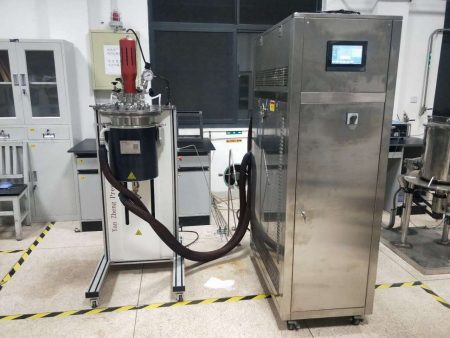
Temperature control method of double-layer jacketed glass reactor
1. Heating by electric heating mantle
Electric heating mantle heating is achieved by wrapping an electric heating mantle outside the reactor. Heating mantles are usually made of metal materials and equipped with intelligent temperature controllers that can set the temperature according to experimental needs. By heating the electric heating mantle, the reactants can react at the set temperature. Since the electric heating mantle has the advantages of uniform heating and adjustable temperature, electric heating mantle heating is one of the commonly used heating methods for double-layer jacketed glass reactors.
2. Hot water circulation heating
Hot water circulation heating is a method of heating by introducing hot water into the reactor jacket. Hot water usually enters the reactor jacket from an external pipe and circulates to keep the temperature constant. Hot water circulation heating has the advantages of high temperature control accuracy and uniform heating, and is suitable for experiments that require precise temperature control. However, hot water circulation heating requires additional water circulation equipment and heating equipment, and the operation is more complicated.
3. Oil bath heating
Oil bath heating is a method of heating by injecting thermal oil into the reactor jacket. Thermal oil has good thermal conductivity and stability, and can maintain a low viscosity at high temperatures. Oil bath heating has the advantages of high temperature control accuracy and uniform heating, and is suitable for experiments that require high-temperature heating. However, oil bath heating requires regular replacement of thermal oil and cleaning of the jacket, which is cumbersome to operate.
4. Refrigeration and heating circulator
Dynamic temperature control from -120℃ to +300℃, rapid cooling and heating with the same heat transfer fluid. Fully sealed pipelines reduce the demand for thermal fluid, and the expansion tank does not participate in circulation. The heat transfer fluid temperature output can be dynamically controlled based on the real-time temperature of the external sensor. It can handle exothermic or endothermic reactions, has high efficiency and stability, reliable and repeatable temperature control curves, magnetic drive pump, no shaft seal leakage, and controllable circulation flow pressure. Siemens PLC module, slope temperature control, multi-stage program temperature control, high precision.

Selection of temperature control methods for double-layer jacketed glass reactors
When selecting the temperature control method for the double-layer jacketed glass reactor, it needs to be considered based on the specific conditions and needs of the experiment. If the experiment requires precise temperature control, you can choose hot water circulation heating or oil bath heating; if the experiment requires rapid temperature rise, you can choose an integrated refrigeration and heating cycle machine. In addition, the safety and environmental protection of the experiment need to be considered, and safe and environmentally friendly heating methods should be given priority.
In short, the double-layer jacketed glass reactor is an important experimental equipment, and the choice of its temperature control method directly affects the success or failure of the experiment and the repeatability of the results. Therefore, in actual operation, it is necessary to choose an appropriate temperature control method according to the specific situation to ensure the accuracy and reliability of the experiment. At the same time, it is necessary to strengthen the maintenance of equipment to ensure the normal operation and service life of the equipment.
温度制御システムの設計から製造まで一貫して行います。標準モデルから完全なカスタマイズ製品まで 900 .私たちはカスタマーサービスに特化し、お客様一人ひとりのニーズに合った最適な温度制御システムを提供することに専念しています。
私達は標準外カスタマイズされた解決を提供します。単一の冷却のスリラーおよび冷却及び暖房のコンボの単位は両方利用できます。
Eメール lilia@lneya.com WeChat ID: +8615251628237 WhatsApp: +86 17851209193


冷暖房システム (SUNDIシリーズ)
- 温度範囲:-120℃〜+350
- 高精度でインテリジェントな温度制御
- 冷却能力:0.5kW~1200kW
- 熱流体の寿命を延ばす完全密閉システム
- 各装置は12時間以上の負荷テストを実施
| 温度範囲 | -10 ~ +150℃シリーズ | -25 ~ +200℃シリーズ | -25 ~ +300℃シリーズ | -45 ~ +250°C シリーズ | -45 ~ +300℃シリーズ | -60 ~ +250°C シリーズ | -60 ~ +300℃シリーズ | -70 ~ +250°C シリーズ | -80 ~ +250°C シリーズ | -90 ~ +250°C シリーズ | -100 ~ +100℃シリーズ | ||
| 冷却能力 | 1.5 ~ 15kW | 1~200kW | 1~200kW | 0.45~200kW | 0.9 ~ 25kW | 0.25 ~ 60kW | 0.75 ~ 25kW | 0.4 ~ 15kW | 0.3 ~ 80kW | 0.2 ~ 80kW | 0.45 ~ 80kW | ||
| 注: -150℃の~ +350℃からの温度較差および冷却容量はカスタマイズすることができる | |||||||||||||
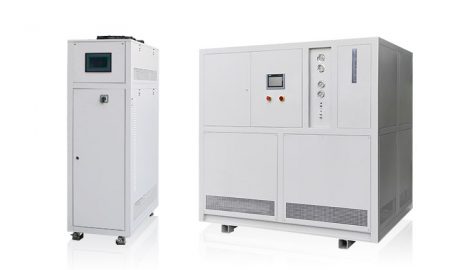
冷暖房システム(WTDシリーズ)
- (マイクロチャンネル・チューブリアクター特化型)
- 温度範囲:-70℃〜+300
- 高性能循環ポンプ、より安定した温度制御効果
- 幅広い温度範囲で、より多くの業界のニーズに対応
- 各装置は12時間以上の負荷テストを実施
| 温度範囲 | -70°C ~ +300°C | -45°C ~ +250°C | -70°C ~ +200°C | ||||||
| 冷却能力 | 1.1 ~ 7.5kW | 1.5 ~ 5.5kW | 11~50kW | ||||||
| 注: -150℃の~ +350℃からの温度較差および冷却容量はカスタマイズすることができる | |||||||||

冷暖房サーキュレーター
- 温度範囲:-45℃〜+250
- エマソンのコープランドコンプレッサー、信頼できる品質
- 自己診断機能、複数の安全保護装置
- 熱流体の寿命を延ばす完全密閉システム
- 各装置は12時間以上の負荷テストを実施
| 温度範囲 | -25°C ~ +200°Cシリーズ | -45°C ~ +250°C シリーズ | |||||||
| 冷却能力 | 1 ~ 15kW | 0.25 ~ 15kW | |||||||
| 注: -150℃の~ +350℃からの温度較差および冷却容量はカスタマイズすることができる | |||||||||
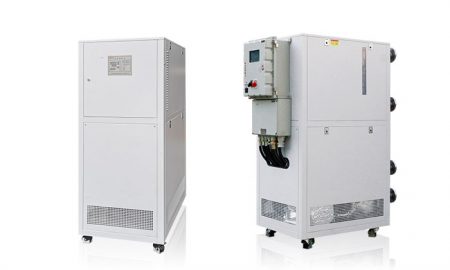
加熱サーキュレーター
- 温度範囲+50℃ ~ +300℃
- 熱交換面積が大きく、加熱速度が速い
- 自己診断機能、複数の安全保護装置
- クローズド循環システム、高温時のオイルミストなし
- 各装置は12時間以上の負荷テストを実施
| 温度範囲 | +50°C ~ +170°C(UCシリーズ) | +50°C ~ +300°C(UCシリーズ) | +50°C ~ +300°C(USTシリーズ) | ||||||
| 暖房能力 | 5.5 ~ 15kW | 3.5~130kW | 3.5〜95kW | ||||||
| 注: -150℃の~ +350℃からの温度較差および冷却容量はカスタマイズすることができる | |||||||||
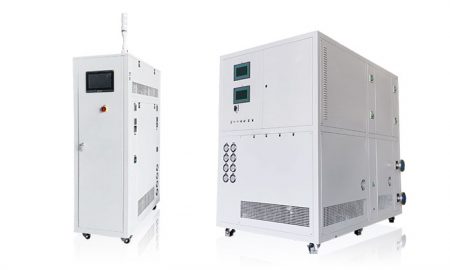
TESシリーズ(燃料・油試験用温度制御装置)
- 温度範囲:-85℃〜+250
- シーメンスPLCコントローラおよびその他のブランドアクセサリー
- 自己診断機能、複数の安全保護装置
- 完全密閉式循環システムにより、高温時のオイルミスト発生なし
- 各装置は12時間以上の負荷テストを実施
| 温度範囲 | -45°C ~ +250°C シリーズ | -85°C ~ +200°Cシリーズ | -60°C ~ +200°Cシリーズ | ||||||
| 冷却能力 | 0.3 ~ 25kW | 0.25 ~ 25kW | 3〜60kW | ||||||
| 注: -150℃の~ +350℃からの温度較差および冷却容量はカスタマイズすることができる | |||||||||
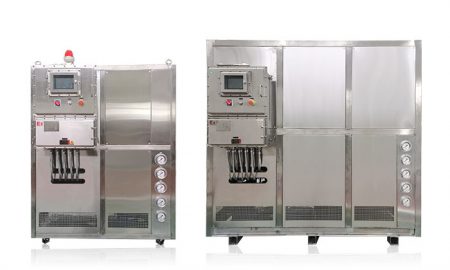
TCU マルチリアクター温度制御システム
- 温度範囲:-120℃〜+250
- 密閉された再現可能な温度制御
- 電気暖房熱油補助システム内蔵
- ニーズに応じて冷熱・熱源熱交換モジュールを追加する
- 各装置は12時間以上の負荷テストを実施
| 温度範囲 | -45°C ~ +250°C シリーズ | -120°C ~ +250°Cシリーズ | カスタマイズされた温度制御システム | RT+10°C ~ +135°C | |||||
| 暖房能力 | 25~80kW | 25~80kW | カスタム | 25~300kW | |||||
| 注: -150℃の~ +350℃からの温度較差および冷却容量はカスタマイズすることができる | |||||||||

循環式チラー / 冷凍サーキュレーター
(カスタムデザイン)
チラーは様々な産業や研究所で広く使用することができ、カスタマイズされた設計をサポートしています。
| 温度範囲 | -25°C ~ +30°Cシリーズ | -45°C ~ +30°Cシリーズ | -60°C ~ -20°Cシリーズ | -80°C ~ -20°Cシリーズ | -120°C ~ -70°Cシリーズ | ||||
| 冷却能力 | 0.8 ~ 30kW | 0.75 ~ 12kW | 0.4 ~ 6kW | 0.2 ~ 6kW | 0.3 ~ 5kW | ||||
| 注: -150℃の~ +350℃からの温度較差および冷却容量はカスタマイズすることができる | |||||||||
 ミニチラー/小型チラー
ミニチラー/小型チラー
(カスタムデザイン)
チラーは様々な産業や研究所で広く使用することができ、カスタマイズされた設計をサポートしています。
| 温度範囲 | -18°C ~ +30°C | +5°C ~ +35°Cシリーズ | |||||||
| 冷却能力 | 0.35 ~ 0.9kW | 1.8~50kW | |||||||
| 注: -150℃の~ +350℃からの温度較差および冷却容量はカスタマイズすることができる | |||||||||

低温チラー
(カスタムデザイン)
当社は、-150℃の温度制御範囲を持つ低温冷凍機の生産を専門としており、さまざまな業界の冷凍ニーズを満たすことができます。
| 温度範囲 | -25°C ~ -5°Cシリーズ | -45°C ~ -10°Cシリーズ | -60°C ~ -10°Cシリーズ | -80°C ~ -30°Cシリーズ | -110°C ~ -50°Cシリーズ | -150℃〜-110℃シリーズ | |||
| 冷却能力 | 12~360kW | 6~180kW | 6~180kW | 4〜180kW | 2~120kW | 2.5 ~ 11kW | |||
| 注: -150℃の~ +350℃からの温度較差および冷却容量はカスタマイズすることができる | |||||||||
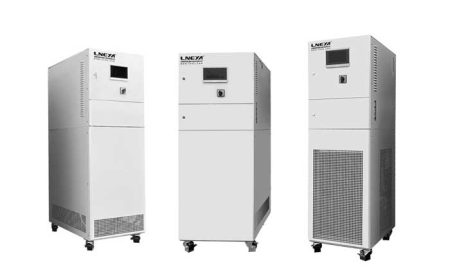
高温チラー
(カスタムデザイン)
チラーは様々な産業や研究所で広く使用することができ、カスタマイズされた設計をサポートしています。
| 温度範囲 | +5°C ~ +40°C | -25°C ~ +40°C | -45°C ~ +40°C | -80°C ~ +80°C | -100°C ~ +80°C | ||||
| 冷却能力 | 6〜40kW | 2~15kW | 1~8kW | 0.6 ~ 3kW | 1.5~3kW | ||||
| 注: -150℃の~ +350℃からの温度較差および冷却容量はカスタマイズすることができる | |||||||||
 LNEYA
LNEYA
 简体中文
简体中文


















































































